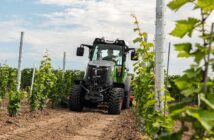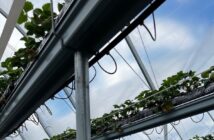Fireblight is the latest disease to be included in Agrovista’s cloud-based pest and disease forecasting service for top fruit growers, Growers Choice Interactive.
The new early warning system, a first in the UK market, is undergoing final trials and will be released in May. It will be available free of charge to GCI subscribers, says Agrovista fruit agronomist Alex Radu.
“Fireblight is a potentially serious disease on apples and pears caused by the bacterium Erwinia amylovora. There is no chemical cure available, so growers have to rely on copper-based preventative or antagonistic sprays before the disease takes hold,” he explains. “This makes accurate forecasting all the more vital.”
Fireblight infection occurs through blossom and new growth when weather is favourable and inoculum is present. The new fireblight software, developed by Dutch pest and disease software forecasting specialist RIMpro, calculates the likelihood of infection based on flowering period obtained from weather information and observation and likely contamination and bacterial growth based on temperature and relative humidity/rainfall.
The quality of the forecast is completely dependant on the accuracy of these weather predictions, says Mr Radu. This information is supplied from live weather data collected by GCI from a network of over 35 weather stations across the country, from which highly accurate local forecasts can be modelled.
“Erwinia becomes a threat at 18C or more, when conditions are wet,” Mr Radu explains. “Growers whose orchards have a history of disease can assume it is there, and we can now help them forecast potential outbreaks with greater accuracy.
“This means we can improve the timing and efficacy of preventative applications, which will be a real benefit to growers in managing disease.
“It will also reduce the number of applications required and ensure they are targeted more effectively, saving growers money and helping to reduce the presence of residues in the environment and the crop.”
The new software cements Agrovista’s lead in online technologies, and confirms GCI as the most up-to-date on-line disease and pest forecasting service for top fruit growers.
The GCI package now includes RIMpro’s primary and secondary scab, codling moth, canker, and fireblight forecasts as well as the weather data recorded at that station. All stations display a 10-day forecast for all the models.
Subscribers can access live graphics, and text alerts are available for major events. Daily emails are also available for the local weather forecast, likely spraying conditions and spray application windows.
What the grower sees
The bar at the bottom shows leaf wetness readings in light blue and active rain as dark blue, as registered by the on-farm weather station.
The lower graph shows the growth of the Erwinia population on the stigma after contamination. Each black line stands for a new group of flowers.
The middle graph shows the potential infection incidence as calculated from flower age and level of the infecting bacterial population.
The upper graph shows the growth within the plant of the Erwinia population after infection.
In this case, taken from an orchard in mid-Europe when the model was being developed, the weather during flowering was very favourable for the development of high Erwinia population levels on the stigma. Six wetness events caused potential infection events.
Since the earliest infections rarely result in symptoms, sprays can be adjusted depending on individual risk management preferences. Nonetheless, at least two sprays were needed to adequately manage fire blight – the first spray in relation to the 20 April infection, and a second spray for flower groups that opened later and which led to infection on 25-28 April.
Fireblight
Fireblight is a notifiable disease, which has helped limit its spread – the most likely means of introduction is via infected material.
Wild shrubs related to apple and pears, notably hawthorn, act as hosts.
Primary infection occurs through lenticels or wounds in young shoots, or through blossom. The disease can spread to other plants by live vectors such as insects and birds, as well as wind and rain.
Growers should keep an eye out for suspicious symptoms, such as wilting and death of flower clusters, withered young shoots and shrivelled black fruits, as well as necrotic patches on leaves.
Late flowering varieties are particularly susceptible as bacterial numbers build during the season. Older trees tend to be less susceptible.



